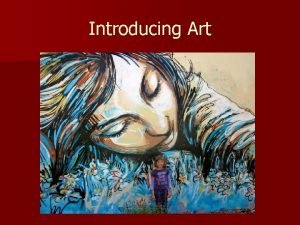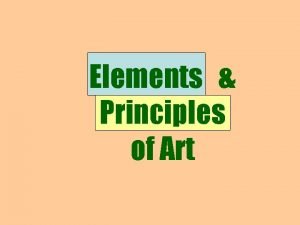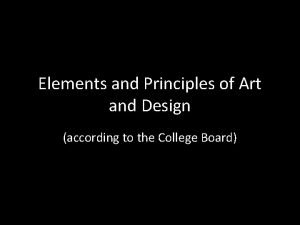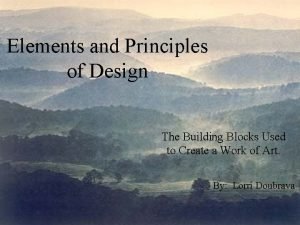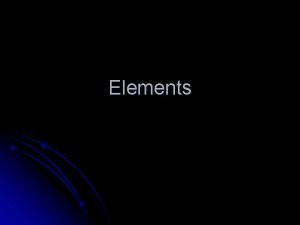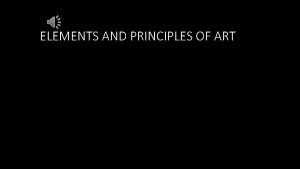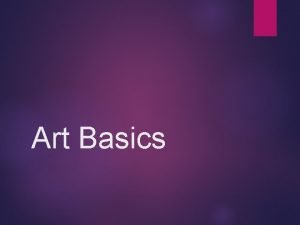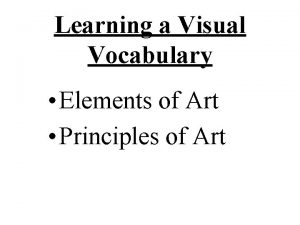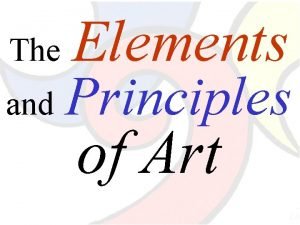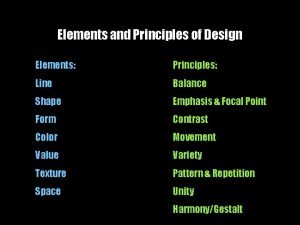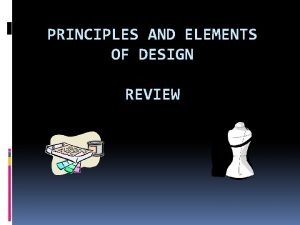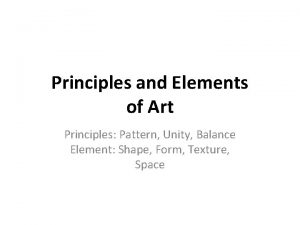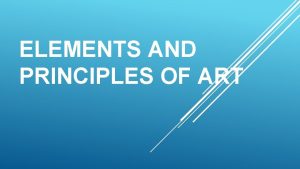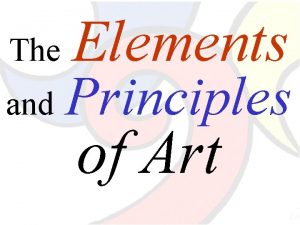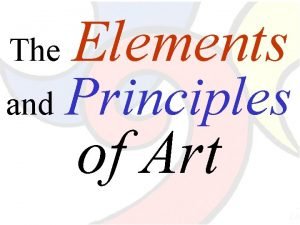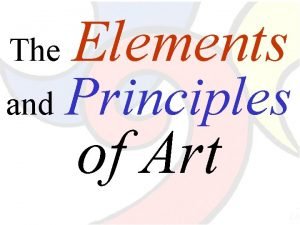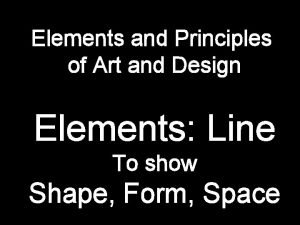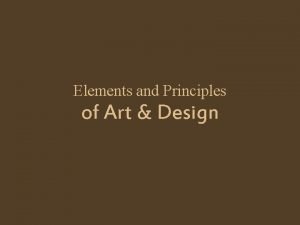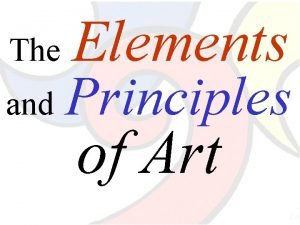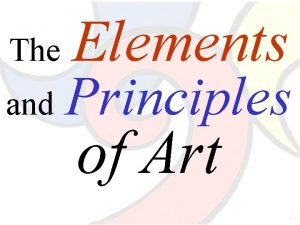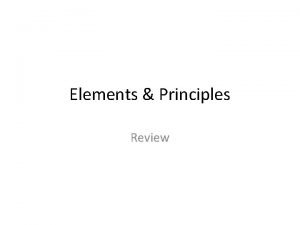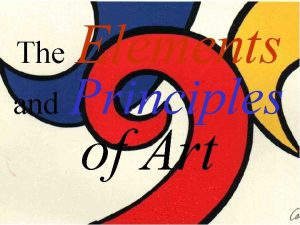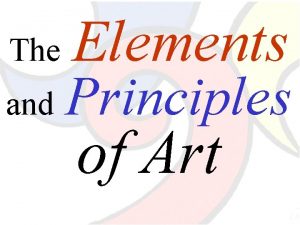Elements Principles of Art Elements of Art The




















- Slides: 20

Elements & Principles of Art

Elements of Art The elements are components or parts which can be isolated and defined in any visual design or work of art. They are the structure of the work, and can carry a wide variety of messages. Line, Shape, Space, Colour, Form, Texture, Value

Line • Line is the path of a moving point. Lines can be vertical, horizontal, diagonal, curved, angular, zigzag, bent, straight, interrupted, thick, thin, parallel, cross-hatched, or spiral. Lines can be implied, an outline showing the edge of something.

Shape • The two-dimensional are enclosed by an outline; height and width. Shape can be realistic, geometric, abstract, idealized, naturalistic, nonrepresentational, amorphous and biomorphic.

Space • The distance or area between, around above, below, and withings. Negative spaces surround positive shapes. Artist create the illusion of a background, foreground, and middle ground.

Colour • • • • Hue Primary colours Secondary colour Tertiary colours Complementary colours Analogous colours Intensity Warm colours Cool colours Neutrals Tone Tint Shade Monochromatic Analogous colours Complementary colours

Form • The three-dimensional height, width and depth. Forms can be cubes, spheres, pyramids, and cylinders. Flowing asymmetrical forms are free form or organic.

Texture • Real or actual texture • Implied or simulated texture: those that can be felt painted or drawn texture • Texture can be slick, smooth, rough, velvety, satiny, bumpy, …

Value • The lightness or darkness of a colour or the lightness or darkness of grey. • For example, black has greater value than grey and white has lesser value than grey.

Principles of Art are the different ways the elements of art have been used in artwork. The elements of art are organized by artist to create a composition. Balance, Repetition, Emphasis, Proportion, Rhythm, Movement, Variety, Unity

Balance • The equilibrium or stability of various elements may be arranged formal (symmetrical) or elements may be arranged informal (asymmetrical). Radial symmetry arranges elements from a central point.

Repetition • An overall interplay of repeated or corresponding parts.

Emphasis • The center of interest or focal point, which may be the largest, brightest, or lightest subject.

Proportion • Refers to relationships - The part in relation to the whole; - How objects relate to each other; - The relation of the object to the frame.

Rhythm • Rhythm is the repetition or alternation of elements, often with defined intervals between them. Rhythm can create a sense of movement, and can establish pattern and texture. Regular: • A regular rhythm occurs when the intervals between the elements, and often the elements themselves, are similar in size or length. • Flowing: A flowing rhythm gives a sense of movement, and is often more organic in nature. • Progressive: A progressive rhythm shows a sequence of forms through a progression of steps. Regular rhythm Flowing rhythm Progressive rhythm

Movement • When the elements are put together to have the illusion of movement and action. It invites the eye to go from one area to the next.

Variety • The use of different elements to draw attention to their differences. Too much causes chaos.

Unity • The harmony of all the visual elements in a composition. The feeling of completeness or wholeness of a balance and organized composition of the elements and principles.

Line, Shape, Space, Color, Form, Texture, Value Elements & Principles of Art Balance, Repetition, Emphasis, Proportion, Rhythm, Movement, Variety, Unity

Finished
 The actual surface feel of the simulated appearance
The actual surface feel of the simulated appearance Elements principles of art
Elements principles of art A feeling of visual equality in shape, form, value, color
A feeling of visual equality in shape, form, value, color Elements and principles of art
Elements and principles of art Elements of design
Elements of design Rhythm and balance in art
Rhythm and balance in art Line shape form color texture space
Line shape form color texture space Basic elements of musical play/theatre
Basic elements of musical play/theatre Principles of art
Principles of art Subject matter
Subject matter What is principle of art
What is principle of art Hình ảnh bộ gõ cơ thể búng tay
Hình ảnh bộ gõ cơ thể búng tay Frameset trong html5
Frameset trong html5 Bổ thể
Bổ thể Tỉ lệ cơ thể trẻ em
Tỉ lệ cơ thể trẻ em Gấu đi như thế nào
Gấu đi như thế nào Chụp tư thế worms-breton
Chụp tư thế worms-breton Chúa sống lại
Chúa sống lại Các môn thể thao bắt đầu bằng tiếng chạy
Các môn thể thao bắt đầu bằng tiếng chạy Thế nào là hệ số cao nhất
Thế nào là hệ số cao nhất Các châu lục và đại dương trên thế giới
Các châu lục và đại dương trên thế giới
